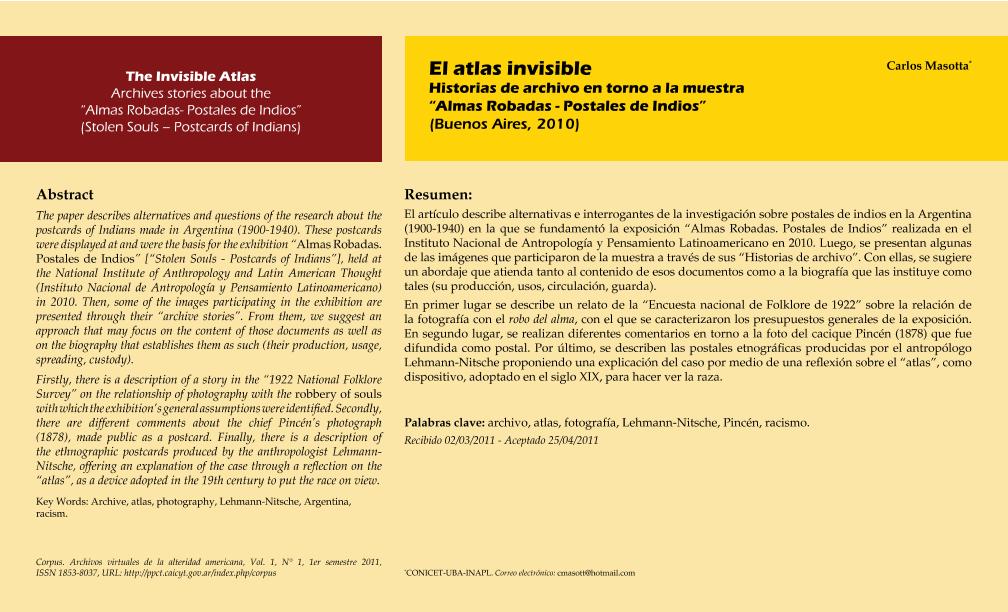Artículo
El artículo describe alternativas e interrogantes de la investigación sobre postales de indios en la Argentina (1900-1940) en la que se fundamentó la exposición “Almas Robadas. Postales de Indios” realizada en el Instituto Nacional de Antropología y Pensamiento Latinoamericano en 2010. Luego, se presentan algunas de las imágenes que participaron de la muestra a través de sus “Historias de archivo”. Con ellas, se sugiere un abordaje que atienda tanto al contenido de esos documentos como a la biografía que las instituye como tales (su producción, usos, circulación, guarda). En primer lugar se describe un relato de la “Encuesta nacional de Folklore de 1922” sobre la relación de la fotografía con el robo del alma, con el que se caracterizaron los presupuestos generales de la exposición. En segundo lugar, se realizan diferentes comentarios en torno a la foto del cacique Pincén (1878) que fue difundida como postal. Por último, se describen las postales etnográficas producidas por el antropólogo Lehmann-Nitsche proponiendo una explicación del caso por medio de una reflexión sobre el “atlas”, como dispositivo, adoptado en el siglo XIX, para hacer ver la raza. The paper describes alternatives and questions of the research about the postcards of Indians made in Argentina (1900-1940). These postcards were displayed at and were the basis for the exhibition “Almas Robadas. Postales de Indios” [“Stolen Souls - Postcards of Indians”], held at the National Institute of Anthropology and Latin American Thought (Instituto Nacional de Antropología y Pensamiento Latinoamericano) in 2010. Then, some of the images participating in the exhibition are presented through their “archive stories”. From them, we suggest an approach that may focus on the content of those documents as well as on the biography that establishes them as such (their production, usage, spreading, custody). Firstly, there is a description of a story in the “1922 National Folklore Survey” on the relationship of photography with the robbery of souls with which the exhibition’s general assumptions were identified. Secondly, there are different comments about the chief Pincén’s photograph (1878), made public as a postcard. Finally, there is a description of the ethnographic postcards produced by the anthropologist Lehmann-Nitsche, offering an explanation of the case through a reflection on the “atlas”, as a device adopted in the 19th century to put the race on view.
El atlas invisible. Historias de archivo en torno a la muestra ''Almas Robadas - Postales de Indios'' (Buenos Aires 2010)
Título:
The Invisible Atlas. Archives stories about the ''Almas Robadas- Postales de Indios'' (Stolen Souls – Postcards of Indians)
Fecha de publicación:
03/2011
Editorial:
Diego Escolar
Revista:
Corpus
e-ISSN:
1853-8037
Idioma:
Español
Tipo de recurso:
Artículo publicado
Clasificación temática:
Resumen
Palabras clave:
Antropología
,
Indígenas
,
Fotografía
,
Estereotipo
Archivos asociados
Licencia
Identificadores
Colecciones
Articulos(SEDE CENTRAL)
Articulos de SEDE CENTRAL
Articulos de SEDE CENTRAL
Citación
Masotta, Carlos Eduardo; El atlas invisible. Historias de archivo en torno a la muestra ''Almas Robadas - Postales de Indios'' (Buenos Aires 2010); Diego Escolar; Corpus; 1; 1; 3-2011; 13-27
Compartir
Altmétricas




